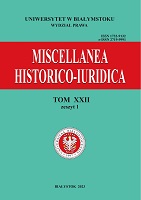Tabula Banasitana Tekst – tłumaczenie – komentarz
Tabula Banasitana Text – Translation – Commentaries
Author(s): Aldona Rita Jurewicz, Konrad TadajczykSubject(s): History of Law, Social history, Ancient World, Roman law
Published by: Wydawnictwo Uniwersytetu w Białymstoku
Keywords: Marcus Aurelius; Commodus; Mauretania Tingitana; Banasa; Tabula Banasitana; Roman Citizenship; Zegrenses;
Summary/Abstract: The Roman Empire entered a period of rapid romanization of the Roman provinces in the 2nd century AD. This also took place, with varying intensity, in African provinces. An expression of this was the granting of Roman citizenship to the leaders of indigenous tribes. The document called Tabula Banasitana, an epigraphic find discovered in the 20th century at the site of the ancient civitas Banasa, documents the process of granting Roman law to the leaders of the Zegrenses tribe and their families. The Roman ius civile was granted to them with the preservation of the rights of their people and without exemptions from public burdens. The author analyzes three documents engraved as an inscription known as Tabula Banasitana, concerning the romanization of the province Mauretania Tingitana. The article describes the process of the gradual incorporation of the North-West African tribal leaders into the structures of the Roman province of Mauretania. Sometimes members of the local elites were granted the status of Roman citizen by the Roman authorities, even though they retained all privileges derived from native law. Through this balanced social policy, Rome was able to keep the peace in frontier areas of the Empire, which were threatened by conflicts with neighbors or, as in this case, nomadic tribes. This form of Roman citizenship was limited – the nature and extent of the restrictions depended on the relationship between the person receiving citizenship and the local community or the Empire’s fiscal interests (for example new citizens were not relieved of obligations like tributum or vectigal). Citizenship was usually granted viritim, but sometimes – as Tabula Bansitana shows – members of the newly minted citizen’s family (wife and children) also received the privilege.
Journal: Miscellanea Historico-Iuridica
- Issue Year: 22/2023
- Issue No: 1
- Page Range: 391-417
- Page Count: 27
- Language: Polish

